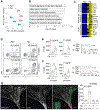Fibrin is a critical regulator of neutrophil effector function at the oral mucosal barrier
- PMID: 34941394
- PMCID: PMC11960105
- DOI: 10.1126/science.abl5450
Fibrin is a critical regulator of neutrophil effector function at the oral mucosal barrier
Abstract
Tissue-specific cues are critical for homeostasis at mucosal barriers. Here, we report that the clotting factor fibrin is a critical regulator of neutrophil function at the oral mucosal barrier. We demonstrate that commensal microbiota trigger extravascular fibrin deposition in the oral mucosa. Fibrin engages neutrophils through the αMβ2 integrin receptor and activates effector functions, including the production of reactive oxygen species and neutrophil extracellular trap formation. These immune-protective neutrophil functions become tissue damaging in the context of impaired plasmin-mediated fibrinolysis in mice and humans. Concordantly, genetic polymorphisms in PLG, encoding plasminogen, are associated with common forms of periodontal disease. Thus, fibrin is a critical regulator of neutrophil effector function, and fibrin-neutrophil engagement may be a pathogenic instigator for a prevalent mucosal disease.
Figures






Comment in
-
Fibrin sparks inflammation in the oral mucosa.Science. 2021 Dec 24;374(6575):1559-1560. doi: 10.1126/science.abn0399. Epub 2021 Dec 23. Science. 2021. PMID: 34941413
References
-
- Tefs K. et al., Molecular and clinical spectrum of type I plasminogen deficiency: A series of 50 patients. Blood 108, 3021–3026 (2006). - PubMed
-
- Schuster V, Hugle B, Tefs K, Plasminogen deficiency. J Thromb Haemost 5, 2315–2322 (2007). - PubMed
-
- Frimodt-Moller J, Conjunctivitis ligneosa combined with a dental affection. Report of a case. Acta Ophthalmol (Copenh) 51, 34–38 (1973). - PubMed
-
- Kurtulus Waschulewski I. et al., Immunohistochemical analysis of the gingiva with periodontitis of type I plasminogen deficiency compared to gingiva with gingivitis and periodontitis and healthy gingiva. Arch Oral Biol 72, 75–86 (2016). - PubMed
-
- Ertas U, Saruhan N, Gunhan O, Ligneous periodontitis in a child with plasminogen deficiency. Niger J Clin Pract 20, 1656–1658 (2017). - PubMed
Publication types
MeSH terms
Substances
Grants and funding
LinkOut - more resources
Full Text Sources
Other Literature Sources
Molecular Biology Databases
Miscellaneous

